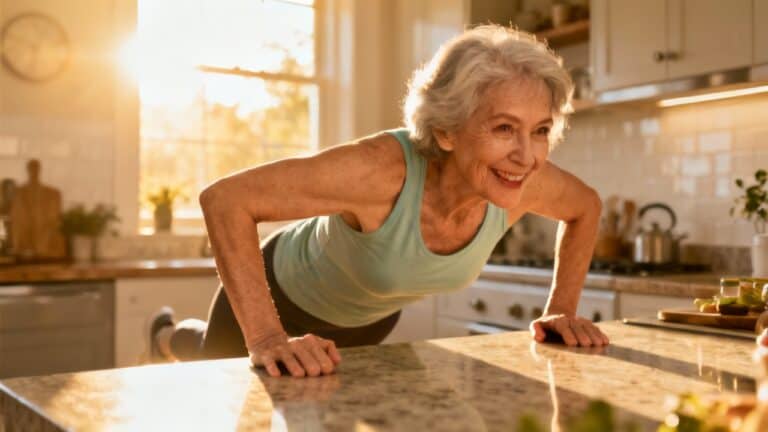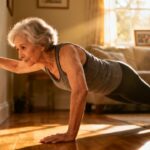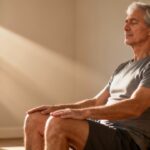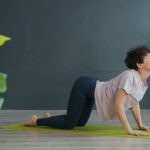What if your daily walk—the one you’ve proudly committed to for years—might not be enough to protect your strength, independence, or brain health after 60?
This might sound surprising, but science is evolving, and if you’re 60 or older, this article could completely change how you think about staying strong, balanced, and mentally sharp.
A growing body of research, including studies from the National Institute on Aging and Mayo Clinic, shows that targeted functional exercises can outperform traditional walking in nearly every measure of aging: muscle strength, fall prevention, and even cognitive function. The best part? They take less time.
Whether you’re 61 or 81, you deserve to feel strong, steady, and fully alive in your body. These aren’t just workouts; they’re tools for reclaiming freedom.
Let’s explore five simple but powerful exercises that are not just replacements for walking—they’re upgrades.
Exercise 1: Counter Push-Ups
Your first step toward upper body strength after 60. Most people think push-ups are only for young athletes, but the truth is, after 60, your upper body strength becomes one of the most important predictors of independence and survival.
From opening jars to pushing yourself out of a chair to catching yourself if you trip, your chest, shoulders, arms, and core are your silent protectors.
Counter push-ups offer a joint-friendly, highly effective way to rebuild this strength without ever getting on the floor.
According to a 2023 study published in the Journal of Functional Aging, seniors who practiced incline push-ups three times a week improved upper body power by 42% and reaction time by 21% in just 8 weeks. That’s not just strength—it’s faster reflexes, better balance, and fewer falls.
How to do it:
Stand facing a sturdy countertop. Place your hands shoulder-width apart. Step back until your body forms a straight line from head to heels. Slowly lower your chest toward the counter. Pause for two seconds, then press back up. Start with six to eight reps, working up to 15. The slower, the better.
Who should be cautious?
Avoid this exercise if you have unhealed shoulder injuries or wrist pain. If full push-ups feel too hard, reduce the incline by standing closer to the counter. Always keep your core engaged and never let your hips sag—form matters more than reps.
Exercise 2: Straight Leg Raises
Rebuilding the foundation of every step you take. We often take walking for granted until one day it feels harder. But what if the secret to walking with ease, climbing stairs, or simply standing up from a chair isn’t in your feet or knees? It’s in your thighs.
As we age, the quadriceps and hip flexors—the powerful muscles at the front of your thigh—begin to weaken rapidly. And once they go, so does your mobility. Straight leg raises are a surprisingly simple but highly targeted way to reverse that decline.
In a 2024 study from the Archives of Physical Medicine and Rehabilitation, older adults who performed straight leg raises four times per week for 6 weeks improved walking speed by 22% and stair climbing ability by 35%. That’s not just impressive; it’s life-changing.
How to do it:
Lie on your back on a firm surface like a yoga mat or bed. Bend one knee, keeping that foot flat. Keep the other leg straight and slowly raise it 12 to 18 inches. Hold for 3 seconds, then lower slowly. Start with six reps each leg, working up to 12 to 15.
Who should be cautious?
Avoid if you have a recent hip replacement or severe lower back pain. You can modify by doing the exercise while seated or with a rolled towel under your knee. If your back arches off the floor, reduce range of motion and tighten your core.
Exercise 3: Step-Ups
Reclaiming your confidence one step at a time. Let’s be honest: stairs can become intimidating after 60. Maybe your knees protest or your balance feels shaky. But avoiding stairs is like giving up a little piece of your freedom each day.
Here’s the good news: the solution isn’t more walking; it’s smarter movement. Step-ups are one of the most powerful exercises you can do to train strength, coordination, and stability all in one simple motion.
A 2023 study from the American Geriatric Society found that older adults who practiced step-ups three times a week improved lower body power by 48% and cut their fall risk by more than half. That’s huge because falling isn’t just scary; it’s life-altering.
How to do it:
Stand facing a sturdy low step 4 to 8 inches high. Step up with your right foot, pressing through your heel. Then bring the left foot up. Step down with control. Start with six to eight reps per leg. Hold a counter for balance if needed.
Who should be cautious?
If you have knee osteoarthritis or recent hip surgery, begin with a lower surface or use a physical therapist’s guidance. Never rush the movement—slow and steady builds strength safely.
Exercise 4: Wall Sits
The silent strength builder that protects your independence. If there’s one silent signal that aging is catching up with us, it’s this: standing up from a chair feels harder than it used to. And that slow fade in leg strength doesn’t just steal your mobility; it steals your confidence.
Wall sits are one of the most underrated exercises for people over 60. Why? Because they build the kind of strength you actually use in daily life: sitting, standing, lifting, and catching yourself if you start to fall.
In a 2023 study from the Stanford Longevity Center, older adults who practiced wall sits just three times a week for 6 weeks improved lower body endurance by 55% and reduced knee pain by nearly half. Even better, MRI scans showed increased activation in the motor cortex, literally retraining the brain to move better.
How to do it:
Stand with your back against a wall. Slide down slowly until your thighs are roughly parallel to the floor, like you’re sitting in an invisible chair. Hold for 15 to 30 seconds. Work up to 1 minute. Rest, then repeat two to three times.
Who should be cautious?
Avoid this move if you have uncontrolled high blood pressure or severe knee arthritis. Modify by sliding down only partway or using a stability ball for support. Never hold your breath. Breathe deeply and steadily throughout.
Exercise 5: Dead Bug
Strengthen your core, protect your brain. Let’s talk about something we don’t usually associate with exercise: your brain. Yes, your brain.
The dead bug exercise may look funny, but it’s one of the most powerful movements you can do after 60—not just for your core, but for your cognitive health, balance, and spinal protection.
According to a 2024 study from the Cleveland Clinic, seniors who practiced this cross-body core movement three times per week showed 38% improvement in balance, 26% reduction in back pain, and most astonishingly, a measurable increase in brain connectivity between the left and right hemispheres.
Why does that matter? Because that kind of neural activation is linked to better memory, sharper thinking, and even lower risk of age-related cognitive decline.
How to do it:
Lie on your back with arms straight up and knees bent at 90 degrees, like a bug on its back. Slowly lower your right arm and left leg toward the floor, keeping your core tight and back flat. Return and repeat on the other side. Start with five to eight reps per side.
Who should be cautious?
Skip or modify this exercise if you have unmanaged lower back issues or neck pain. You can start by moving just arms or just legs separately. Always keep movement slow, controlled, and your core gently engaged.
Conclusion: You’re Not Just Growing Older—You’re Growing Stronger
This article wasn’t just about exercises; it was about reclaiming something deeper: your strength, your balance, your independence, your future.
We’ve been told for years that walking is the gold standard after 60. And while walking is wonderful, it’s only one piece of the puzzle.
What we need—what you deserve—is a routine that builds the kind of strength that actually protects your life: the strength to rise from a chair without effort, the balance to step off a curb with confidence, the resilience to keep moving, thinking, and thriving on your own terms.
These five exercises—counter push-ups, straight leg raises, step-ups, wall sits, and dead bug—aren’t just alternatives to walking. They’re smarter, more targeted tools backed by real science and real results.
You don’t need to do them perfectly; you just need to start. Progress, not perfection—that’s the rule here. And remember, you are not too old; you are just undertrained in the right way. You’re not here to fade quietly; you’re here to get strong inside and out.








